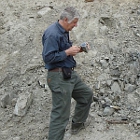Decar project holds groundbreaking potential

Peter Bradshaw, First Point Minerals' president and CEO (L), and Trevor Rabb, project geologist, examine the discovery outcrop on the Baptiste target.
Peter Bradshaw, First Point Minerals' president and CEO (L), and Trevor Rabb, project geologist, examine the discovery outcrop on the Baptiste target. — photo courtesy First Point Minerals
First Point Minerals, with the participation of Cliffs Natural Resources, has demonstrated groundbreaking innovation in its exploration for "naturally occurring stainless steel"—referred to as nickel-iron alloy—at its Decar property in central British Columbia. First Point has developed a method of selective extraction for exclusive use by the company; this involved developing an accurate way to assay solely for alloy nickel as opposed to total nickel.
“This is essentially a grassroots discovery of a new style of nickel mineralization right here in British Columbia,” said Rob Robertson, vice-president of corporate development. “What we are doing is very groundbreaking.”
Dr. Peter Bradshaw is president and CEO of First Point Minerals.
“There are two real aspects to the innovation, in both the style of mineralization and the environmental impact,” said Bradshaw. “Of course, the low environmental impact helps make it more commercially viable as well.”
Bradshaw said the company spotted the possibility of this new style of mineralization about 14 years ago. The mineral itself, awaruite, is a naturally occurring alloy of nickel and iron and is referred to as a nickel-iron alloy.
“We looked at a polished thin section sample which contained this mineral and thought 'here is an intriguing idea: a naturally occurring stainless steel,' ” said Bradshaw.
He added that when they looked into it, they realized that although the mineral had been known for well over 100 years, no one had ever appeared to have looked at it from a commercial point of view. Bradshaw thinks the fundamental reason for this is that there is no visible clue that this mineralization is there.
“The rock looks like an everyday, ordinary barren rock,” said Bradshaw. “We have developed some visual methods to help us narrow down, in the field, the correct rock type to start with. We looked at several areas and had a major breakthrough at Decar finding this alloy over a significantly sized area—an area which is equivalent in size and tonnage to a porphyry copper deposit.”
Bradshaw explained that a characteristic of this alloy is that it is highly magnetic, quite dense and heavy. Therefore, it can potentially be recovered by both magnetic and gravity means.
“These are tried-and-true methods, off the shelf, and have been around for decades and decades,” said Bradshaw. “They don't use chemicals and have the potential to be quite a lot more cost effective, as the product can be sold directly to a steel mill because there are no associated sulphides and no smelting required.”
Bradshaw pointed out that another positive aspect of not having any sulphides is that there will be no acid rock drainage, which is something that almost every mine has to manage.
“No sulphides and no acid rock drainage makes for an environmentally green mining project,” said Robertson.
“We had what we thought was a really good idea and a property which we thought was novel and interesting,” said Bradshaw. "With a junior company with just two key people, it is pretty hard to push back the frontiers of science, so we knew we would need a partner.”
Cliffs Natural Resources, a Fortune 500 company, fits the bill perfectly. Cliffs Natural Resources, has been in business for over 160 years, Bradshaw said, and it has operating mines in Canada, the United States, Australia and Brazil.
“They signed an option/joint venture with us based solely on surface samples and due diligence work," said Robertson. “At that point, it was at a very early stage and it was more the concept that they were buying into."
Bradshaw said that Cliffs Natural Resources saw the potential of something very large.
"They really liked the size potential and the low environmental impact,” he said.
Under this agreement, Cliffs Natural Resources can earn 51 per cent on the project by spending US$4.5 million over four years; then their option is to increase it to a total of 75 per cent by completing a bankable feasibility study.
Robertson said that last year nine widely spaced holes were drilled to test the Baptiste and Sidney targets, over a distance of 1,600 metres. The drilling all ended in mineralization.
“The drilling was also done to collect fresh metallurgical samples,” said Robertson. “The test work began at Christmastime and we expect to have the results of that work this summer. Based on the results of the preliminary metallurgical test work that has been done to date, it's been positive and no red flags raised. The drilling planned for the summer will likely cost another million dollars.”
Robertson concluded that the Decar project holds near-surface, bulk-tonnage and open-pittable potential.
“Decar, if it is successful, will have a significant impact on the area there as any mine does,” said Bradshaw. "We see ourselves with a significant competitive edge. We are out there diligently looking for more nickel-iron alloy prospects and we have committed $2 million for that.”



